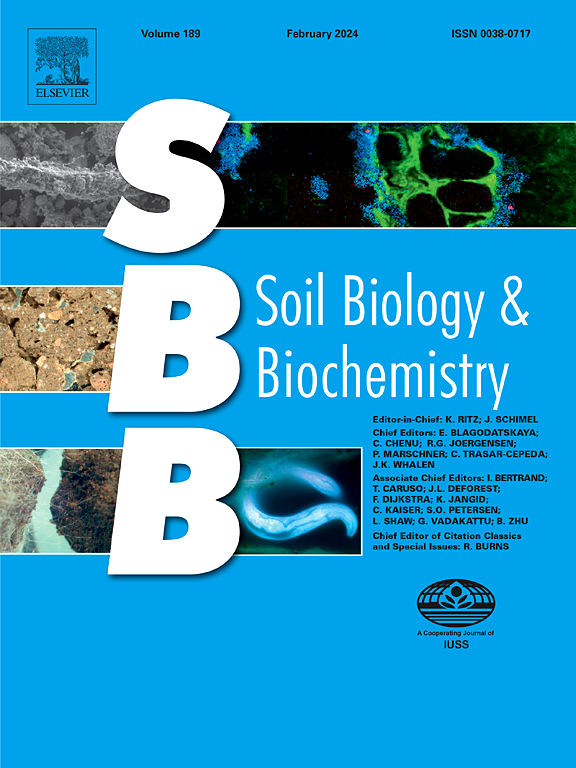Moisture-mineral interactions drive bacterial and organic matter turnover in glacier-sourced riparian sediments undergoing pedogenesis
IF 9.8
1区 农林科学
Q1 SOIL SCIENCE
引用次数: 0
Abstract
Glacial recession is occurring at unprecedented rates resulting in increased sediment accumulations in some riverine ecosystems providing new mineral surfaces for soil formation. Soils and sediments have an enormous potential to retain carbon (C), predominantly due to sorption to mineral surfaces. However, C persistence may be sensitive to climate-change induced temperature and moisture variations. We coupled ultrahigh resolution organic matter composition classification with bacterial characterization and respiration measurements to test the combined pedogenic effects of temperature (4 vs 20 °C) and moisture (50 vs 100% water-filled pore space) on C turnover in sediments maintained under different mineralogical conditions (illite-amended vs non-amended). Here we show that the inhibition of CO2 emissions from the combined effect of increased moisture content and illite was reflected in the turnover of key molecular signatures, such as the nominal oxidation state of C, often irrespective of temperature. However, shifts in bacterial communities from a coupled moisture-mineral interaction, were temperature-dependent. Our results highlight the importance of moisture in driving mineral-organic interactions and suggest that C in clay-rich, water-saturated sediments is both thermodynamically unfavorable and mineral-protected from microbial consumption.
水分与矿物质的相互作用推动了冰川源河岸沉积物中细菌和有机物的更替,这些沉积物正经历着植被形成过程
冰川正在以前所未有的速度消退,导致一些河流生态系统中的沉积物堆积增加,为土壤的形成提供了新的矿物表面。土壤和沉积物具有保留碳(C)的巨大潜力,这主要归功于矿物表面的吸附作用。然而,碳的持久性可能对气候变化引起的温度和湿度变化很敏感。我们将超高分辨率有机物成分分类与细菌特征描述和呼吸测量结合起来,测试了温度(4˚C 与 20˚C)和湿度(50% 与 100% 水填充孔隙空间)对在不同矿物学条件(伊利石改良与非改良)下保持的沉积物中碳周转的综合影响。我们在此表明,湿度增加和伊利石的共同作用对二氧化碳排放的抑制反映在关键分子特征(如 C 的名义氧化态)的变化上,通常与温度无关。然而,细菌群落在水分和矿物质耦合作用下的变化与温度有关。我们的研究结果突显了湿度在驱动矿物-有机物相互作用中的重要性,并表明富含粘土的水饱和沉积物中的碳在热力学上是不利的,而且矿物保护作用使其不会被微生物消耗。
本文章由计算机程序翻译,如有差异,请以英文原文为准。
求助全文
约1分钟内获得全文
求助全文
来源期刊

Soil Biology & Biochemistry
农林科学-土壤科学
CiteScore
16.90
自引率
9.30%
发文量
312
审稿时长
49 days
期刊介绍:
Soil Biology & Biochemistry publishes original research articles of international significance focusing on biological processes in soil and their applications to soil and environmental quality. Major topics include the ecology and biochemical processes of soil organisms, their effects on the environment, and interactions with plants. The journal also welcomes state-of-the-art reviews and discussions on contemporary research in soil biology and biochemistry.
 求助内容:
求助内容: 应助结果提醒方式:
应助结果提醒方式:


